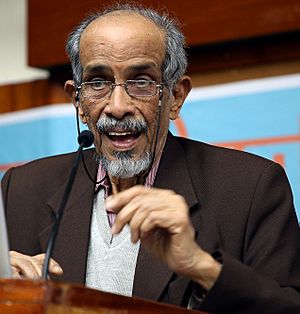Roddam Narasimha facts for kids
Quick facts for kids
Roddam Narasimha
|
|
|---|---|
 |
|
| Born | 20 July 1933 |
| Died | 14 December 2020 (aged 87) Bangalore, Karnataka, India
|
| Alma mater | Mysore University Indian Institute of Science California Institute of Technology |
| Scientific career | |
| Fields | Fluid dynamics |
| Thesis | Some Flow Problems in Rarefied Gas Dynamics (1961) |
| Doctoral advisor | Hans W. Liepmann |
| Doctoral students | K. R. Sreenivasan Rama Govindarajan |
Roddam Narasimha (20 July 1933 – 14 December 2020) was a brilliant Indian scientist. He was an expert in aerospace and fluid dynamics. Fluid dynamics is the study of how liquids and gases move.
He taught Aerospace Engineering at the Indian Institute of Science for many years (1962–1999). He also led the National Aerospace Laboratories (1984–1993). Later, he chaired the Engineering Mechanics Unit at Jawaharlal Nehru Centre for Advanced Scientific Research (2000–2014). In 2013, he received the Padma Vibhushan. This is India's second-highest award for civilians. He earned it for helping India's aerospace technology grow.
Contents
Early Life and Education
Roddam Narasimha was born on July 20, 1933. His family came from a village called Roddam in Andhra Pradesh, India. His father, R.L. Narasimhaiah, was a physics professor. He also wrote science books in the Kannada language.
Narasimha went to school in Bangalore. He earned his first degree in mechanical engineering. This was at the University Visvesvaraya College of Engineering. During this time, he visited the Indian Institute of Science. He saw a Spitfire aircraft there. This sparked his interest in airplanes.
After graduating in 1953, he joined the Indian Institute of Science. He earned his master's degree in engineering in 1955. He worked with Satish Dhawan, who later led the Indian Space Research Organisation. Then, Narasimha went to the United States. He completed his doctorate in 1961 at the California Institute of Technology. His advisor was Hans Liepmann.
Career and Scientific Contributions
Narasimha began his research at Caltech. He first worked on making jet engines quieter. After the launch of the Russian satellite Sputnik, space became a big focus. He then started studying rarefied gas and fluid dynamics. This involved how gases behave in very thin air.
He continued this work at the NASA Jet Propulsion Laboratory. There, he studied how air moves at very high speeds. This helped him understand shockwaves better. He even used one of NASA's first computers for his research.
Return to India and Key Research
In 1962, Narasimha returned to India. He became a professor at the Indian Institute of Science. He continued his fluid dynamics research. He studied turbulent flow, which is chaotic fluid movement. He also looked at relaminarisation. This is when a chaotic flow becomes smooth and streamlined again.
He held many important positions in India. He was the Director of the National Aerospace Laboratories (1984–1993). He also led the National Institute of Advanced Studies (1997–2004). He was a visiting professor at many international universities. These included the University of Cambridge and Caltech. He also advised former Prime Minister Rajiv Gandhi on science.
Innovations in Aerospace
While at the National Aerospace Laboratories, Narasimha led research into parallel computing. This is a way to solve complex problems using many computers at once. His work led to India's first parallel computer. It also helped create a weather prediction code for tropical regions. He also helped design India's light combat aircraft.
Over his long career, he made big contributions to fluid dynamics. He studied how clouds move, using experiments and computer models. He also researched gas turbine blades. He even suggested a new wing design for turboprop aircraft.
He was a long-serving member of the Indian Space Commission. This group makes policies for space exploration in India. He resigned in 2012. This was to protest the blacklisting of some former ISRO scientists.
Awards and Recognitions
Roddam Narasimha received many honors for his work. He was an honorary member of the American Academy of Arts and Sciences. He was also a Fellow of the Royal Society of London. This is a very prestigious science academy.
Some of his important awards include:
- 1975 – SS Bhatnagar Prize
- 1987 – Padma Bhushan, India's third highest civilian award.
- 2000 – Fluid dynamics Award, American Institute of Aeronautics and Astronautics
- 2008 – Trieste Science Prize, The World Academy of Sciences
- 2013 – Padma Vibhushan, India's second highest civilian award
- 2019 – Lifetime Achievement Award for Mentoring in Science, from Nature Magazine
He wrote over 200 research papers and fifteen books.
Personal Life
Roddam Narasimha passed away on December 14, 2020. He was 87 years old. He died from a brain haemorrhage in Bangalore. He is remembered for his amazing contributions to science.
Books
- Narasimha, Roddam (1961) (in en). Orifice Flow at High Knudsen Numbers. Guggenheim Aeronautical Laboratory. https://books.google.com/books?id=RbwKyAEACAAJ.
- Narasimha, Roddam (1962) (in en). Collisionless Expansion of Gases Into Vacuum. Guggenheim Aeronautical Laboratory. https://books.google.com/books?id=Q2_6xwEACAAJ.
- Narasimha, Roddam; Ojha, S. K. (1967) (in en). Effect of Longitudinal Surface Curvature on Boundary Layers. https://books.google.com/books?id=KlyNAQAACAAJ.
- Narasimha, Roddam; Srinivasan, J.; Biswas, S. K. (2003) (in en). The Dynamics of Technology: Creation and Diffusion of Skills and Knowledge. SAGE. ISBN 978-0-7619-9670-5. https://books.google.com/books?id=XpFxcweodqQC.
- Kalam, APJ Abdul; Narasimha, Roddam; Dhawan, Satish (1988) (in en). Developments in Fluid Mechanics and Space Technology: Asian Congress of Fluid Mechanics. https://books.google.com/books?id=MWPlGwAACAAJ.
See also
 In Spanish: Roddam Narasimha para niños
In Spanish: Roddam Narasimha para niños

